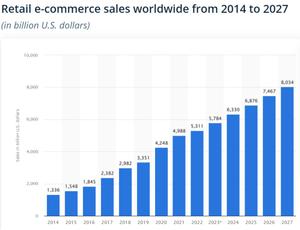7 Must-Have Features Your B2B PIM Software Should Have in 2025
Sector: Digital Commerce
Author: Nisarg Mehta
Date Published: 10/11/2024

Contents
Over the past five years, the global eCommerce market has grown by over 100% in sales. This growth has been even more remarkable in B2B eCommerce, the size of which is now six times bigger than B2C eCommerce

Watching this sector grow, businesses are embracing omnichannel strategies to fulfill customer expectations, which is where PIM (Product Information Management) systems have come into play to help companies manage product data on channels.
A PIM system is essential for B2B businesses to be efficient. This means they can organize and spread product data impeccably and consistently across all platforms. There are so many features when choosing the right PIM software to help you ‘scale’ your operations and satisfy the ever-increasing demands of a fast-growing market.
What is a PIM Software?
Product Information Management (PIM) software enables you to put all of your product data in one place. This collects, stores, and makes available essential product information like descriptions, images, tech specs, and pricing across different channels. PIM software ensures that the right information is everywhere you need it to be for B2B businesses where accuracy and consistency matter.
For B2B, keeping thousands of products and related data across many websites can get messy quickly. This gets easier with a PIM system that acts as a central hub for all product-related information including what is current with all channels: your website, third-party marketplaces, or partners.
Top 7 Features Your B2B PIM Software Must Have
If you’re considering PIM software for your B2B business, you should pick the software that has all the necessary features. Here are the must-haves:

1. Centralized Data Management
Centralized data management is literally one of the most paramount features you should look for in any PIM system. This feature is rather in the interest that all your product information is managed in one place that includes product descriptions, product specifications, images, pricing, and so on. This is especially important for B2B businesses as it helps keep the consistency throughout numerous sales channels reducing the chance of mistakes and discrepancies.
Centralized data management means that you are not responsible for manually updating product information on all platforms. The data is updated in the PIM system and then distributed automatically throughout all appropriate channels, which saves you time and reduces the fuss. To that end, this not only helps increase efficiency but also guarantees precision that product information is accurate across all touchpoints, which is especially important for B2B environments where accuracy is a question of making or breaking deals.
2. Scalability & Flexibility
Any PIM system, particularly for a B2B company, needs to scale. If you grow your business, you are going to have more and more products, SKUs, sales channels, and regions. A scalable PIM system will guarantee this growth does not impact the system’s performance.
Equally important is flexibility. Alongside scalability, your PIM must also be adaptable to the shifting demands of your business: add a new product, integrate with other systems, welcome languages beyond English, and manage any currency beyond the dollar and Euro. Flexible and scalable PIM means that your business can go forward and keep your product management processes unchanged.
3. Integration With Digital Asset Management (DAM)
In B2B business, managing a large spectrum of product content including images, videos, and technical documents is important. However, that’s when it’s crucial to integrate Digital Asset Management (DAM) into your PIM system. If you’re using a good PIM system, you can put all related digital assets in one place and manage them through your DAM.
When DAM integrates it, you know every product has the digital assets associated with it as it needs to be distributed across all sales and marketing channels. With that, you no longer have to manage separate repositories for product data and for digital content. And it means your digital assets are always up to date which makes your marketing and your product listings much more effective.
4. Data Syndication & API Integrations
Data syndication, which often is a crucial part of any PIM system for B2B companies working with multiple channels and partners is a must. So, a good PIM software should also permit error-free data syndication, that is, it should be able to disseminate product data efficiently to different platforms such as your e-commerce platform, third-party marketplaces, or partner systems.
API integrations are equally as important. PIM is a system that can be very effective in communicating through API to other systems such as ERP, CRM, and eCommerce. This way, you ensure real-time data flow and smooth operation among various parts of your business in order to maintain consistency throughout. By integrating these systems you can run a more efficient business and run less data discrepancy risk.
5. Localization & Multilingual Capabilities
Localization and multilingual features are essential for B2B businesses operating in multiple regions because a PIM system will be used by stakeholders from all over the world. A PIM with good localization support permits you to localize and customize product information to every market’s particular needs (local language, currency, and regional rules and regulations).
With the capability to oversee several languages within your PIM system, you can connect with your clients all around the world. In addition to ensuring accuracy in this feature, it also improves the customer experience by providing region-specific product information. When you are gradually expanding internationally, the need to localize your product data will grow in importance for you to stay competitive.
6. Workflow Automation
Another important feature of PIM software is its workflow automation since B2B businesses with large numbers of products require managing them seamlessly. A PIM that has automation capabilities can take away from you doing certain repetitive things such as updating product descriptions, prices, or specifications. This allows businesses to save time and minimize the chance of human error on these tasks.
When data is updated across channels, workflow automation allows you to create rules for when and how your data is updated so that nothing is done manually. In a world where customer demand is continually evolving, and where products are changing and changing fast, this is particularly useful.
7. User Friendly Interface and training support.
When choosing a PIM system for your B2B business, you will not only need its functionality but also a user-friendly interface. An intuitive and seamless PIM decreases the learning curve, making it easy to use and train teams to use without extensive training. So, the employee spends less time trying to understand how the system works, and more time using it to boost productivity.
Moreover, strong PIM vendor training support is also important. The right resources, whether it’s detailed documentation, tutorial, or customer support give your team access to the necessary resources to use the PIM system to its full potential. Staying ahead on your business needs is supported by a vendor that provides ongoing support and regular updates.
Picking a PIM Solution; Which Vendor to Choose Then?
When choosing the right PIM software for your B2B business, there are several factors you should consider:
1. Assess Your Business Needs
Before that, evaluate your specific business requirements. Think about how many products you’re managing, how many sales channels you’re on, and if you’re branching out into different geographic regions. It will help to determine what PIM system can operate in the current and the nearest future.
2. Capabilities of Integration must be considered.
Also, ensure your selected PIM may be simply implemented with your current systems (ERP, CRM, etc., and eCommerce platform). Through seamless integration, data moves smoothly between systems protecting you from inconsistencies and preventing manual work.
3. Evaluate Vendor Support
Growing your business requires vendor support. You want to find a PIM vendor that provides ongoing support, regular updates, and training. With this, you’ll have all the support you need to ensure that your PIM system grows with your business and enables you to stay ahead of the market curve.
4. Proof of Concept (PoC)
It is a good idea to run PoC before fully committing to a PIM system. Avoiding the black box approach to services and products, allows you to test the software in your own environment and see if the software can handle your data, integrate with your current systems, and meet your specific requirements.
How to Maximize Success with the Right PIM Systems
Choosing the right PIM software is essential to B2B companies looking to make their product management process more scalable. A strong PIM solution centralizes product data, manages their corresponding digital assets, and guarantees that the information is consistent across all channels. You can scale to support more users, automate workflows, and integrate with existing systems—shortening the amount of time your dev team needs to build new solutions every six months.
The key to leveraging your PIM for long-term success in your B2B landscape is by understanding your needs and choosing a PIM system with the right features that will improve your operational efficiency.
We know that if you are thinking, ‘How do I really integrate PIM Software’ in my business, such that it hits on all the keynotes at once including efficiency and scalability, then you need the services of a leader in eCommerce software development like Techtic Solutions. Partnering with a firm such as Techtic Solutions and adopting the right PIM for B2B will improve operational efficiency and contribute to your long-term success within the B2B landscape.



